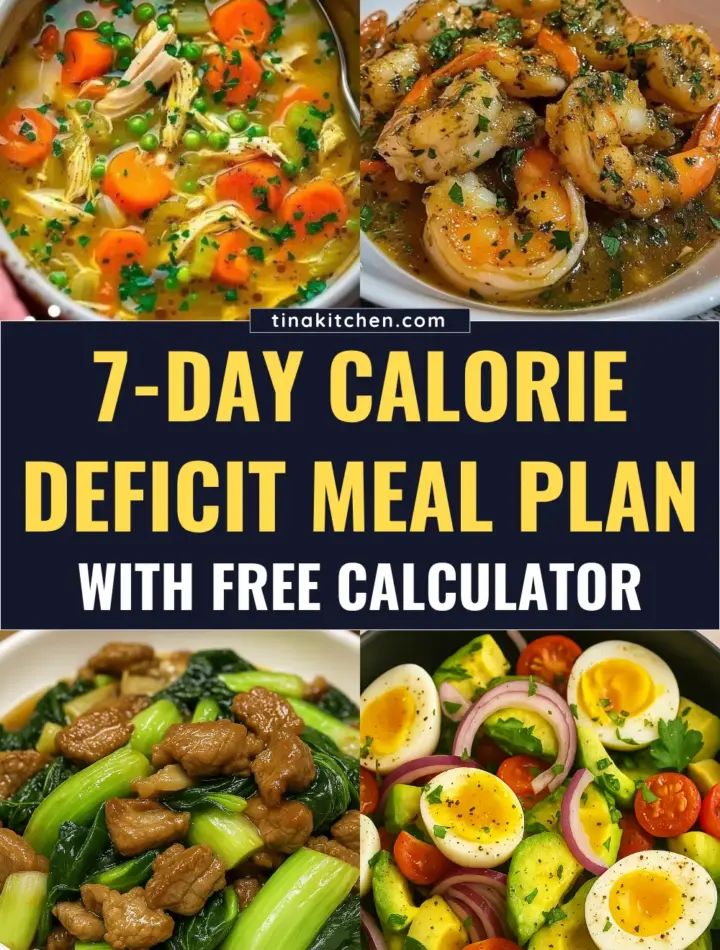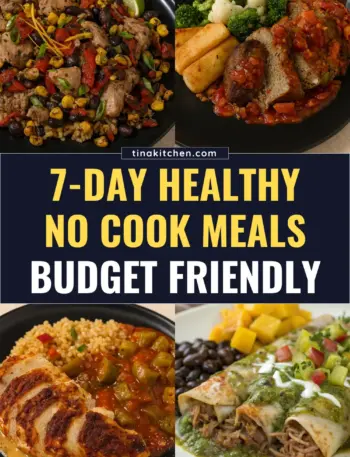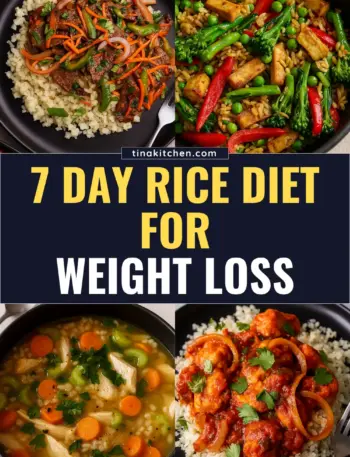This post may contain affiliate links, meaning I may earn a commission if you make a purchase, at no extra cost to you. I only recommend products I trust. Thank you for your support.
Table of Contents
What is a Calorie Deficit Diet?
A calorie deficit diet is an eating plan where you consume fewer calories than your body needs to maintain its current weight.
Your body needs energy (calories) to fuel everything you do, from breathing to walking.
Our calorie deficit meal plan features healthy calorie deficit meals filled with whole foods (proteins, vegetables, fruits, and whole grains) that keep you satisfied.
Your body needs a certain amount of energy (calories) each day to function, and this includes activities like breathing, digesting food, walking, and exercising.
If you don’t give it enough calories through food, it makes up the difference by using stored energy, usually body fat.
If you eat more calories than you burn, the excess is stored (mainly as fat).
Conversely, when you consume fewer calories than your body burns, your body must tap into stored energy (fat) to make up the difference.
How Does Calorie Deficit Work?
When you eat in a deficit, your body is forced to use stored energy (mostly body fat) to make up the difference, which leads to weight loss over time.
Experts generally recommend a moderate deficit of about 500 to 1000 calories less than maintenance per day.
This usually yields about 0.5 to 1 kg (1 to 2 pounds) of weight loss per week. For example, eating approximately 500 calories less per day (vs. your maintenance level) is a safe way to shed about one pound per week.
For example:
- If your body needs 2200 calories a day to maintain your weight, but you only eat 1700, you are in a 500 calorie deficit.
- Consistently doing this helps the body gradually burn fat while still providing enough energy for daily activities.
A calorie deficit can be achieved by:
- Eating less (controlling portion sizes, choosing lower-calorie foods).
- Burning more fat (through exercise and physical activity).
- A mix of both (which is usually the most effective and sustainable).
Calorie Deficit for Men vs. Women
Men and women have different calorie needs due to factors like muscle mass, body size, and hormones.
Generally, men burn more calories per day than women of the same age, because men tend to have more muscle.
For example, a Nutrition study notes that women typically require about 1600 to 2400 calories/day to maintain weight (depending on activity), whereas men often need around 2000 to 3000 calories/day.
This means on average, a calorie deficit for men might start from a higher baseline intake than for women.
For example, if a moderately active woman’s maintenance is 1800 cal, a 500 cal deficit would be about 1300 cal/day.
A moderately active man might have 2400 cal maintenance, making a 500 cal deficit about 1900 cal/day.
The percentage deficit can be similar for both genders, but the absolute calories differ.
How to Calculate Your Calorie Deficit
Before you start eating at a deficit, it helps to know your maintenance calories, the number of calories you’d eat to neither lose nor gain weight.
This is often estimated by calculating your Total Daily Energy Expenditure (TDEE), which factors in your Basal Metabolic Rate (BMR) and activity level.
Use our free calorie deficit calculator below to find your daily calorie needs and the right calorie deficit to lose weight effectively.
Once you have your maintenance calories, create a deficit.
For example, if your maintenance is 2000 cal/day, eating 1500/day would typically burn about 500 of stored calories per day, or 1 pound/week.
Free Calorie Deficit Calculator
Simply enter your details in the calorie deficit calculator below to estimate your BMR, TDEE, and how many calories you should eat per day to safely reach your goals.
7 Day Calorie Deficit Meal Plan (Calorie Deficit Meals)
This calorie deficit meal plan features easy calorie deficit meals for breakfast, lunch, dinner, and snacks with a focus on high protein high fiber foods between 1200 to 1400 calories daily.
Serving sizes should be adjusted to your specific calorie targets (e.g., larger portions for men, smaller for women, based on the calculator).
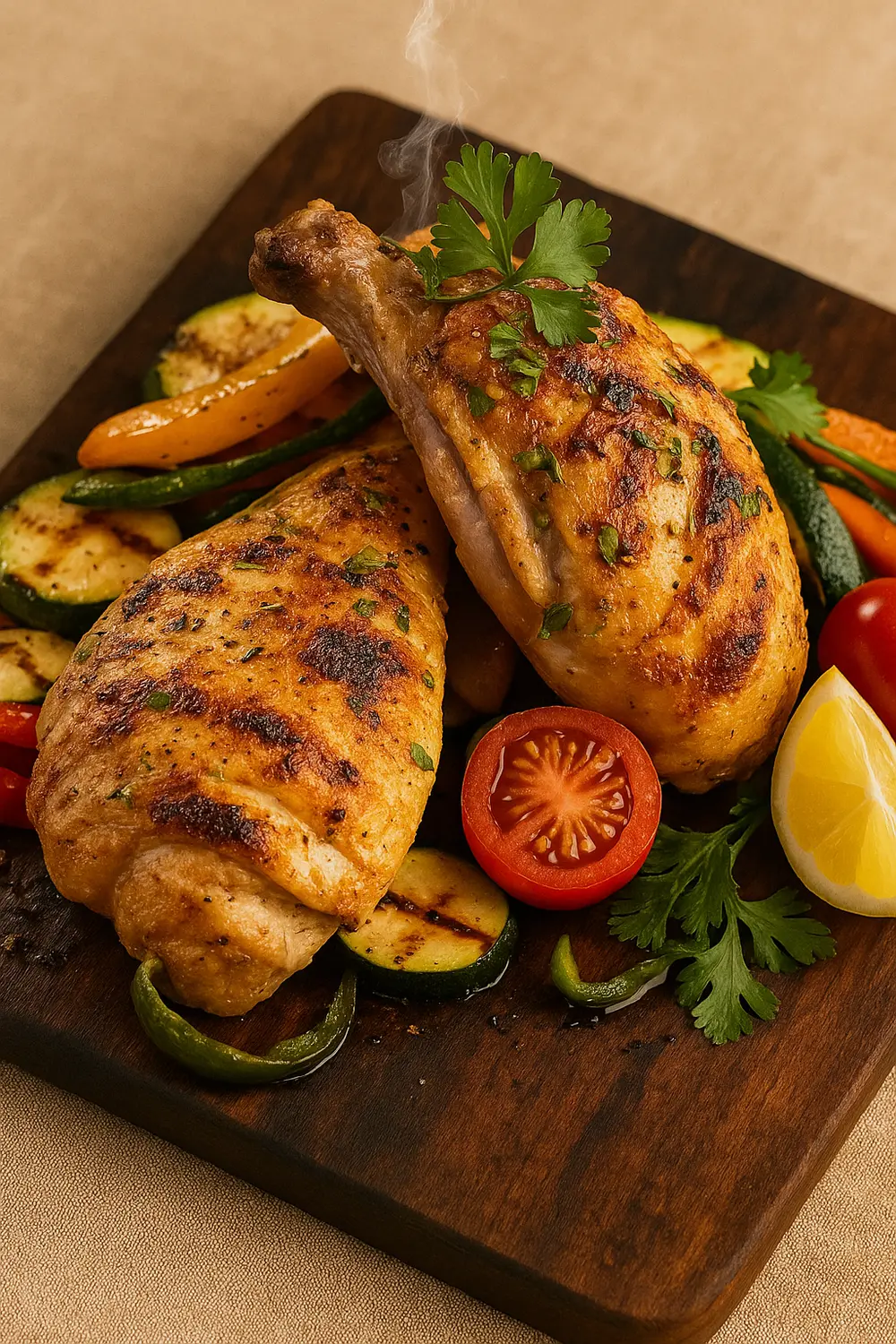
Day 1
Breakfast:
- Spinach Feta Egg Scramble: A filling start packed with protein. Scramble eggs (or egg whites) with fresh spinach, cherry tomatoes, and mushrooms, and sprinkle feta cheese on top.
Lunch:
- Korean Cucumber Salad: A refreshing, crunchy side dish made with crisp cucumber slices tossed in a tangy, garlicky dressing with sesame oil, soy sauce, rice vinegar, and a hint of red chili flakes.
Dinner:
- Herb-Roasted Chicken with Veggies: Roasted chicken breast seasoned with garlic, rosemary, and thyme, served alongside steamed broccoli and sliced carrots.
Snacks:
- Energy Power Trail Mix: Mix a handful of raw almonds, walnuts, pumpkin seeds, and a few dried apricots or raisins. Portion it to about ¼ cup to keep calories in check.
- Cottage Cheese & Berries: A small bowl of low-fat cottage cheese topped with fresh berries (strawberries, blueberries, or raspberries).
Daily Nutrition: 1240 calories, 95g protein, 38g fat, 120g carbs, 19g fiber

Day 2
Breakfast:
- Overnight Oats with Berries: Prepare rolled oats soaked overnight in unsweetened almond milk or low-fat milk, with a spoonful of chia seeds. In the morning, top with fresh blueberries, sliced banana, and a sprinkle of cinnamon.
Lunch:
- Classic Greek Salad: A crisp, vibrant salad of cucumbers, tomatoes, red onions, bell peppers, Kalamata olives, and creamy feta cheese, tossed in a lemon-oregano dressing for a light Mediterranean touch.
Dinner:
- Coconut Fish Soup with Lime: A healthy low low calorie high protein soup with tender fish fillets simmered in coconut milk, ginger, and lemongrass, finished with a squeeze of fresh lime for brightness.
Snacks:
- Greek Yogurt Parfait: Layer plain Greek yogurt (0% or low-fat) with a handful of raspberries and a sprinkle of high-fiber granola or crushed nuts.
- Carrots & Hummus: This combo gives you fiber and some plant-based protein (from the chickpeas in hummus) without many calories.
Daily Nutrition: 1285 calories, 89g protein, 40g fat, 130g carbs, 25g fiber
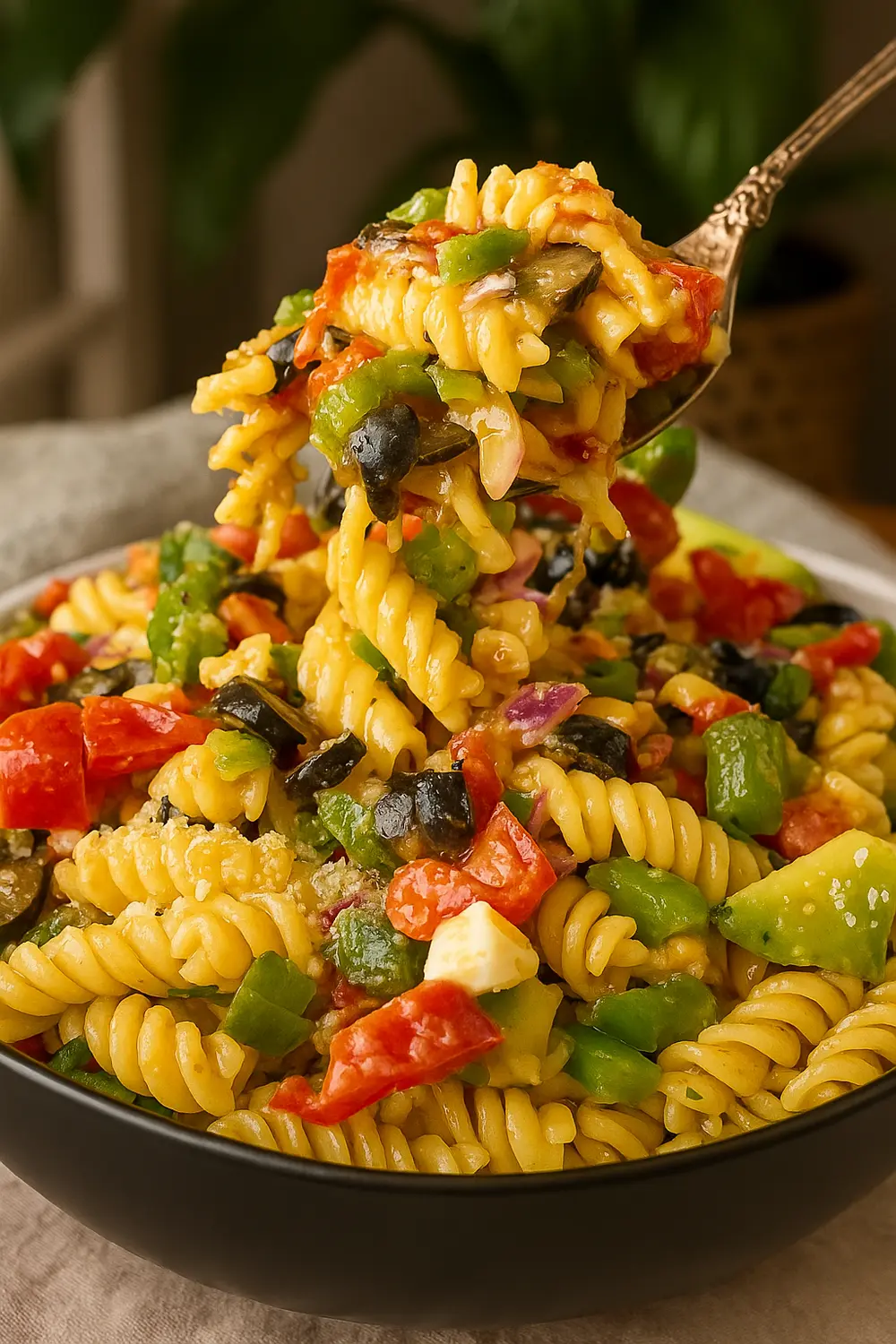
Day 3
Breakfast:
- Veggie Egg White Omelet: Whip up an omelet with egg whites and/or a whole egg, packed with chopped spinach, diced tomatoes, and sliced mushrooms.
Lunch:
- Italian Pasta Salad: Al dente pasta tossed with cherry tomatoes, cucumbers, black olives, mozzarella, and fresh basil in a zesty Italian vinaigrette, perfect for a calorie deficit lunch.
Dinner:
- Coconut Chicken Curry with Rice: Tender chicken simmered in a creamy coconut milk curry sauce with fragrant spices and served over brown rice, perfect for those seeking out calorie deficit dinner ideas.
Snacks:
- Healthy Sweet Potato Bars: A wholesome treat made with mashed sweet potatoes layered over a golden, buttery crust, lightly sweetened and spiced with cinnamon.
- Turkey Roll-Ups: Take 2 to 3 slices of lean turkey breast, spread a thin layer of light cream cheese or mustard, and roll up around a dill pickle spear or a strip of bell pepper.
Daily Nutrition: 1320 calories, 101g protein, 44g fat, 135g carbs, 21g fiber
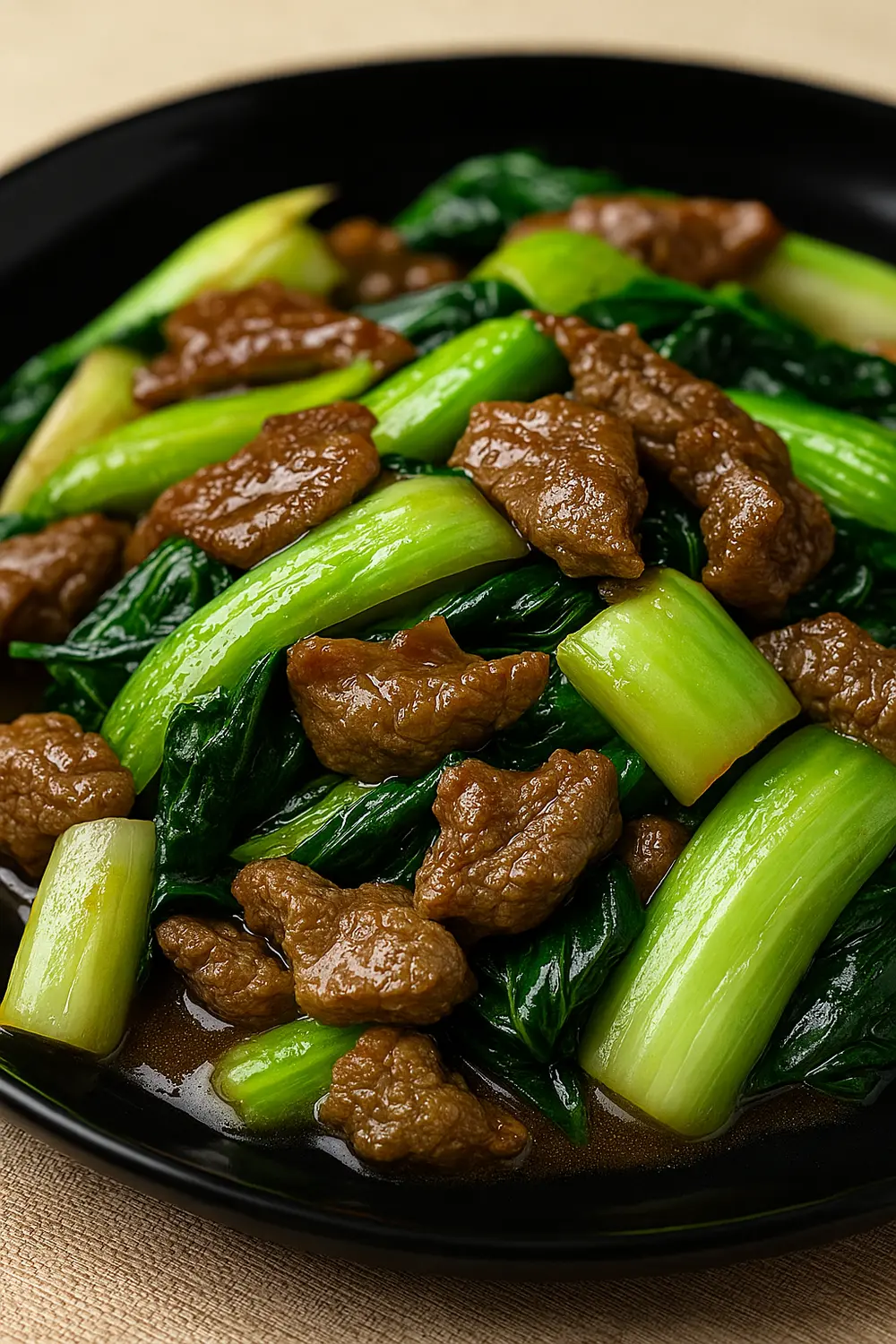
Day 4
Breakfast:
- Greek Yogurt with Nuts & Honey: Bowl of plain Greek yogurt (0% or low-fat) drizzled with a teaspoon of honey, topped with a sprinkle of chopped mixed nuts (almonds, walnuts, pistachios) and a dash of cinnamon.
Lunch:
- Avocado Cucumber Salad: Creamy avocado cubes and crisp cucumber slices mixed with red onion, lemon juice, and fresh herbs. A light, cooling salad with a buttery texture and zesty finish.
Dinner:
- Beef & Vegetable Stir-Fry: Stir-fry lean beef strips (such as flank steak or sirloin) with broccoli florets, sliced bell peppers, and onions. Use a splash of low-sodium soy sauce or teriyaki.
Snacks:
- Protein Shake: Blend a scoop of protein powder (whey or plant-based) with water or unsweetened almond milk and ice. You can add a handful of spinach or a few frozen berries.
- Mixed Berry Smoothie: This drink is hydrating, high in antioxidants, and only 100 calories per cup. Add a handful of spinach for extra fiber and nutrients.
Daily Nutrition: 1265 calories, 98g protein, 42g fat, 128g carbs, 21g fiber
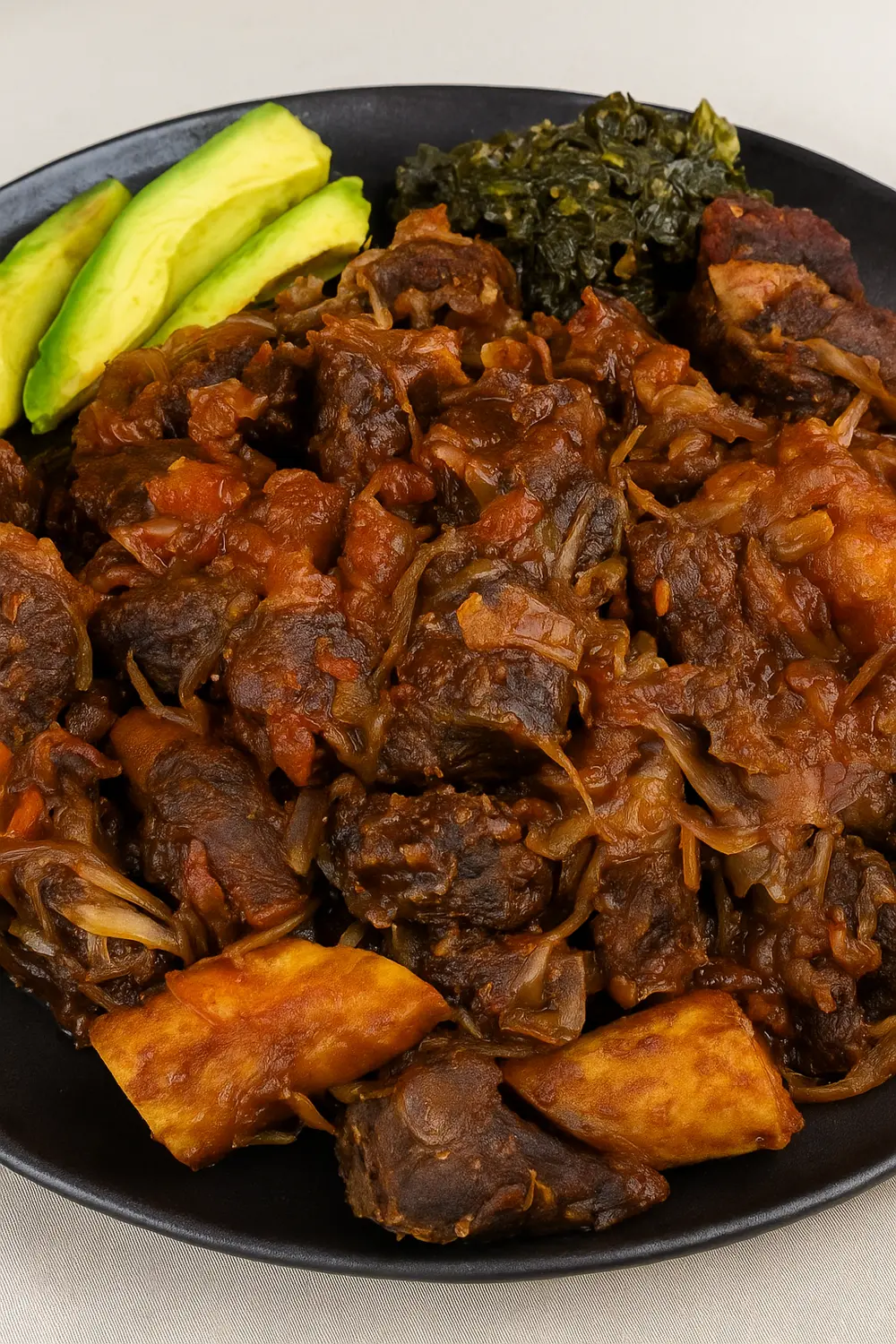
Day 5
Breakfast:
- Protein Pancakes: Make pancakes by blending oats, egg whites (or whole eggs), and a banana into a batter (you can also use a scoop of protein powder or cottage cheese for extra protein).
Lunch:
- Jerusalem Salad with Falafel: A fresh chopped salad of cucumbers, tomatoes, and parsley drizzled with tahini, served alongside crispy golden falafel balls. A classic calorie deficit lunch meal.
Dinner:
- Ugandan Pork Stir Fry (Kikalayi Pork): Crispy, well-seasoned pork chunks stir-fried with cabbage, onions, peppers, and chilies in a savory-spicy sauce, and served with matooke, avocado, and greens.
Snacks:
- Cottage Cheese with Fresh Berries: Scoop some low-fat cottage cheese into a bowl and top with a handful of fresh berries like blueberries, raspberries, or strawberries.
- Rice Cakes with Almond Butter: Light, crunchy rice cakes spread with 1 tablespoon of almond or peanut butter. You can add a sliced banana on top if you like.
Daily Nutrition: 1345 calories, 105g protein, 47g fat, 141g carbs, 25g fiber
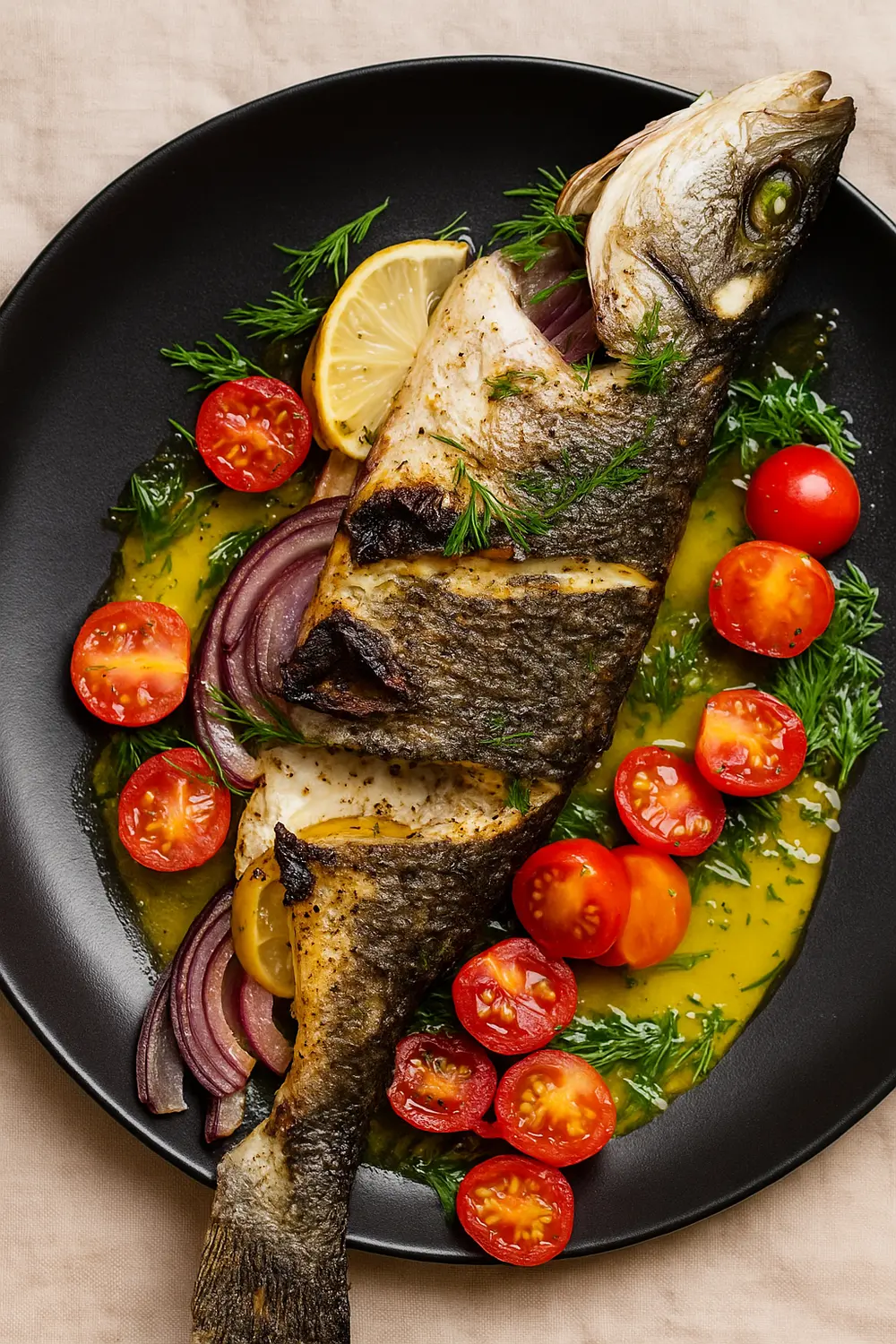
Day 6
Breakfast:
- Veggie Breakfast Burrito: Scramble eggs (or egg whites) with black beans, diced tomatoes, onions, and a pinch of cumin. Wrap the mixture in a lightly toasted whole-wheat tortilla with a tablespoon of shredded cheese and a spoonful of salsa.
Lunch:
- Grilled Mediterranean Sea Bass: Whole sea bass grilled with a zesty ladolemono sauce made from lemon, olive oil, oregano, and fresh herbs, served with a side of roasted vegetables
Dinner:
- Chicken and Broccoli Casserole: A cozy, family-style casserole with tender chicken, crisp broccoli, and a creamy cheese sauce baked until bubbly with a golden crust.
Snacks:
- Bell Pepper Strips & Guacamole: Dip bright bell pepper strips into 2 to 3 tablespoons of homemade or store-bought guacamole (mashed avocado with lime, salt, cilantro).
- Greek Yogurt Berry Bark: Mix plain Greek yogurt with a teaspoon of honey and spread it on a sheet. Sprinkle sliced berries and crushed nuts on top, then freeze.
Daily Nutrition: 1290 calories, 102g protein, 40g fat, 133g carbs, 21g fiber
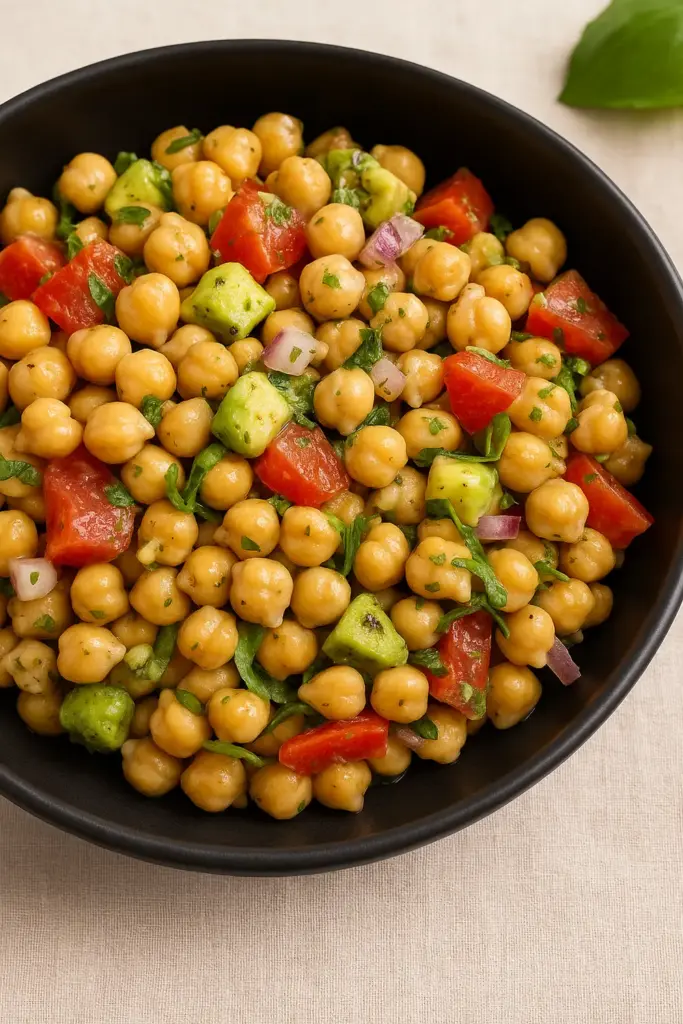
Day 7
Breakfast:
- Avocado Toast with Egg: Spread mashed avocado on one slice of whole-grain toast. Top with a poached or fried egg (use cooking spray to limit added fat) and cherry tomato halves.
Lunch:
- Avocado and Chickpea Salad: A protein-packed salad combining creamy avocado, chickpeas, cucumber, and cherry tomatoes with a lemon-herb dressing, one of the best calorie deficit meals.
Dinner:
- Mediterranean Ground Beef: Savory ground beef cooked with garlic, onions, and a blend of Mediterranean spices, paired with roasted vegetables and fresh herbs.
Snacks:
- Dark Chocolate Trail Mix: Combine a small handful of mixed nuts (almonds, cashews, pistachios) with a few dark chocolate chips and dried cranberries.
- Celery Sticks with Peanut Butter: Celery sticks paired with 1 tablespoon of peanut butter (or almond butter). This classic snack gives you crunch and a hit of protein and healthy fat.
Daily Nutrition: 1275 calories, 98g protein, 43g fat, 132g carbs, 21g fiber
Best Calorie Deficit Foods
In a calorie deficit diet, food quality matters. You want to feel full and energized while still cutting calories. The key is low-calorie density, nutrient-dense foods. These include:
- Vegetables: Most vegetables are very low in calories but high in volume, fiber, and water. For example, leafy greens, broccoli, carrots, zucchini, peppers, and other non-starchy veggies fill your plate but won’t push calorie counts up.
- Fruits: Whole fruits (not juice) are great low-calorie snacks or sides. Berries, apples, oranges, bananas, grapefruit, and so on provide fiber and sweetness with fewer calories than processed snacks.
- Lean Proteins: Good sources include chicken or turkey breast, fish and seafood, lean cuts of beef or pork, egg whites, low-fat dairy (Greek yogurt, cottage cheese), and plant proteins like tofu, tempeh, legumes (beans, lentils, peas).
- Whole Grains & Starches: Choose whole grains and complex carbs for lasting energy. Oatmeal, brown rice, quinoa, whole-wheat pasta/bread, sweet potatoes, and legumes (which also count as protein) are better than refined grains.
- Healthy Fats & Nuts: While fats have more calories per gram, small amounts of healthy fats (avocado, olive oil, nuts, seeds) are part of a balanced calorie deficit diet. They add flavor and help absorb vitamins. Nuts and seeds (almonds, walnuts, pumpkin seeds, chia seeds) provide protein, fiber, and good fats.
- Herbs and Spices: Herbs, spices, citrus, vinegar, and low-sodium broths can make low-calorie meals tasty without many calories. Garlic, ginger, cumin, basil, cilantro, chili flakes, lemon/lime juice, and hot sauce are excellent choices for a calorie deficit meal plan.
Potential Risks of a Calorie Deficit Diet
While a calorie deficit diet is one of the most effective ways to lose weight, it’s not without potential downsides if taken too far or followed incorrectly. Here are some common risks to be aware of:
- Nutrient Deficiencies: Eating too few calories can make it hard to get enough vitamins, minerals, and essential fatty acids. Over time, this may lead to fatigue, brittle hair and nails, or a weakened immune system.
- Brain Drain: Your brain actually burns a significant amount of calories every day, so when your energy intake drops too low, it can leave you feeling mentally sluggish, struggling to concentrate, and slower.
- Low Energy & Fatigue: When calories are cut too aggressively, you may feel constantly tired, weak, or unable to focus, making workouts and daily activities harder.
- Hormonal Changes: Extended periods of severe calorie restriction can affect hormones like leptin, ghrelin, and thyroid hormones, which regulate hunger, energy, and metabolism.
- Disordered Eating Patterns: Strict dieting and constant restriction may increase cravings, binge eating tendencies, or an unhealthy relationship with food.
- Slower Metabolism: Extremely low calorie diets can signal your body to conserve energy, making long-term weight loss harder.
Final Remarks
This calorie deficit meal plan is designed to help you reduce your daily calorie intake while still enjoying balanced, flavorful, and nutrient-rich foods.
Instead of focusing only on eating less, think about fueling your body with the right foods, such as lean proteins, fiber-rich vegetables, whole grains, and healthy fats that keep you satisfied while still keeping calories in check.
Pairing this eating approach with regular physical activity, proper hydration, and adequate rest will help you achieve your goals healthily and sustainably.
And most importantly, before starting any calorie deficit diet, consult with a healthcare professional or registered dietitian, especially if you have existing health conditions, to ensure this approach is safe and effective for you.
Also, check out these meal plans;
- Ozempic diet for beginners
- Weight loss meal prep ideas
- What is the rice diet for weight loss?
- Easy high protein low carb meals
- Mounjaro diet for beginners
- 7-day low carb eating plan
- High protein diet for beginners
- Gluten free meal plan
- 1200 calorie diet plan
- Endomorph diet plan
FAQs
How many calories should I eat per day to lose weight?
Generally, aim for about 500 fewer calories than your TDEE each day. For example, if a calculator shows you burn 2,000 cal/day, eating around 1500 cal can yield about 1 lb (0.5 kg) loss per week.
What foods are best for a calorie deficit diet?
Low-calorie, high-volume foods are best for a calorie deficit. Dietitians recommend lots of vegetables and fruits (high in water and fiber) and lean proteins (chicken, fish, tofu, beans, eggs).
How long will it take to see weight loss on a calorie deficit diet?
Weight loss pace varies by person, but with a consistent calorie deficit, you often see changes in a few weeks. A typical rule is 1 to 2 pounds (0.5 to 1 kg) per week with a 500 to 1000 calorie daily deficit.
How do I calculate my calorie deficit?
You can calculate your calorie deficit by first finding your daily calorie needs using our free calorie deficit calculator, then subtracting 300 to 500 calories per day to create a safe weight loss range.
For example, if your body needs 2000 calories to maintain weight, eating 1500 to 1700 calories puts you in a healthy calorie deficit to lose weight steadily.
Is eating 1200 calories a day a calorie deficit?
For many women, 1200 calories may be the lowest safe intake, while for men it’s often too restrictive.
A moderate deficit of 300 to 500 calories below your daily needs is usually more sustainable and supports better energy, nutrition, and long-term weight loss.

